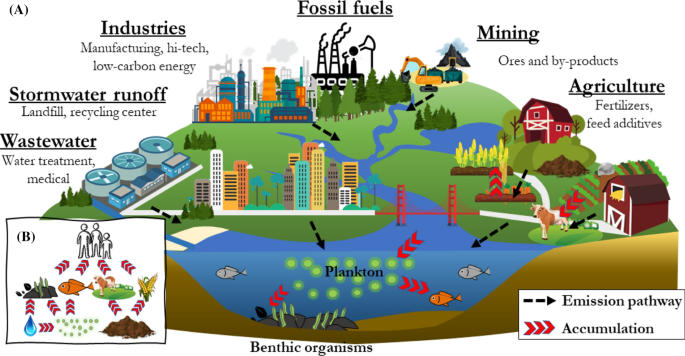Understanding the Critical Technology Element is essential in today's tech-driven world. It impacts innovation and progress across various fields.
Critical Technology Element (CTE) refers to a key component or technology crucial for the development of a system or product. It's the backbone of many advanced systems, ensuring functionality and efficiency. From the latest smartphones to state-of-the-art defense systems, CTEs play a pivotal role.
They are the building blocks for modern advancements, enabling breakthroughs in performance and capability. Without CTEs, many of today's innovations would remain concepts. In this blog post, we'll explore what makes these elements so vital and how they shape the future of technology. Stay tuned to uncover the significance and applications of Critical Technology Elements.
Critical Technology Elements
Technology elements are very important. They help make new things. Hardware and software are key parts. Hardware includes things you can touch. Like computers and phones. Software is the programs inside. These tell hardware what to do.
New ideas need technology. It helps create better tools. Technology makes work easier and faster. Robots can do jobs people find hard. AI can think and learn. This helps solve big problems. Technology is very important for the future.

Credit: link.springer.com
Emerging Trends
Technology is changing fast. Artificial Intelligence now helps in many fields. Healthcare uses AI to find diseases early. Robots work in factories and homes. Virtual Reality (VR) makes gaming and learning fun. VR also helps doctors practice surgeries. Electric cars are getting better and cheaper. They help save the planet. 5G networks are here. They make internet speed super fast.
Quantum computers might solve big problems. They will be faster than today's computers. Smart cities will use tech to make life easy. Streets, lights, and homes will be smart. Wearable tech will be common. Watches and glasses will do more. Space travel might be for everyone. People could visit Mars. Green technology will grow. It will help keep our world clean.
Impact On Industries
Critical technology changes healthcare. Doctors use advanced tools for better diagnosis. Patients get quick results. Telemedicine helps people in remote areas. Wearable devices track health 24/7. They help in early detection of problems. Hospitals use robots for surgeries. Robots make surgery more precise. These changes save lives. They also reduce costs.
Technology boosts manufacturing. Machines work faster than humans. They make fewer mistakes. Automation helps in building products quickly. Quality improves as a result. Factories use 3D printing for making parts. It saves time and money. Robots handle dangerous tasks. This ensures worker safety. Smart factories use data to improve. They adapt quickly to changes.

Credit: www.jsa.net
Role Of Artificial Intelligence
Artificial Intelligence plays a big role in automation. Machines can now perform tasks without human help. This saves time and reduces mistakes. Factories use AI to control robots. These robots do repetitive jobs faster. They also work more accurately. AI software helps in offices too. It can handle data entry and simple customer queries. This allows people to focus on more important tasks.
Data analysis is easier with AI. Large amounts of data can be examined quickly. Patterns and trends are found fast. This helps companies make better decisions. AI tools can predict future trends. This is useful in business planning. Errors in data are spotted easily. This improves the accuracy of the analysis. AI also helps in medical research. It can analyze patient data to find disease trends.
Sustainable Technologies
Green energy solutions can help our planet. Solar panels use sunlight to make electricity. Wind turbines turn wind into power. These methods reduce the use of fossil fuels. This helps to lower pollution levels. Switching to green energy can save money over time. It can also create jobs in new fields. Investing in these technologies is smart.
Sustainable tech can reduce harm to nature. Clean energy decreases carbon emissions. This slows down global warming. Protecting forests helps wildlife. Less pollution means cleaner air and water. It is important to use resources wisely. Simple changes can make a big difference. Everyone can help protect the environment.
Challenges And Solutions
Technological barriers can be hard. People face outdated systems and limited resources. Many devices do not connect well. Security risks are high. This makes it tough to trust new tech. Old habits are hard to change. Some people fear losing jobs to machines. High costs also stop progress. Many small companies cannot afford new tech. These challenges slow growth.
Training programs help people learn new skills. Companies invest in cybersecurity to protect data. Grants and loans support small businesses. Open-source software cuts costs. Cloud services improve connection. Teams work to make user-friendly tech. Sharing knowledge helps everyone grow. These solutions can make tech barriers easier to manage.
Investment And Funding
Governments support technology growth. They offer grants and loans. These help new tech firms start. They also fund research. This leads to new inventions. They create tax breaks for tech companies. This saves money. It encourages growth.
Businesses invest in new tech. They see profit potential. Venture capitalists fund startups. They expect big returns. Tech giants buy small firms. They want new ideas. Crowdfunding helps too. Many people give small amounts. Together, it makes a big sum.
Future Prospects
Technology is always changing. It can shape our future. It helps solve big problems. Many jobs will depend on new tech. It can make life easier. But it can also cause challenges. Everyone needs to adapt. Kids must learn new skills. Adults too. This is important for all of us.
New tech can do amazing things. Robots may help in homes. Medicine can find cures. Energy can be cleaner. Internet will be faster. Travel may be quicker. Many things will change. This can be good. It can help everyone. But we must be ready. Always stay curious. Always keep learning.

Credit: iupac.org
Frequently Asked Questions
What Is A Critical Technology Element?
A critical technology element (CTE) is vital to the success of a project. It is essential for meeting technical performance requirements and achieving desired outcomes.
Why Are Critical Technology Elements Important?
CTEs are crucial because they ensure the project's technical success. Identifying and managing CTEs helps mitigate risks and ensures project goals are met efficiently.
How To Identify Critical Technology Elements?
Identify CTEs by analyzing project requirements and performance goals. Focus on technologies that are essential for achieving desired outcomes and meeting technical specifications.
What Are Examples Of Critical Technology Elements?
Examples of CTEs include advanced materials, cutting-edge software, and innovative hardware components. They are crucial for the project's success and performance.
Conclusion
Understanding critical technology elements is essential for success in today's digital world. These elements drive innovation and efficiency. They impact every industry. Businesses must stay updated with tech advancements. Adopting new technologies can streamline operations. It can also improve customer satisfaction.
Staying informed and adaptable ensures competitiveness. Embrace these critical elements to thrive. Technology continues to evolve rapidly. Be proactive. Stay ahead. This knowledge can lead to smarter decisions. It can also foster growth and development. Keep learning and exploring new tech trends.
This will help secure your place in the future.
.png)






0 Comments